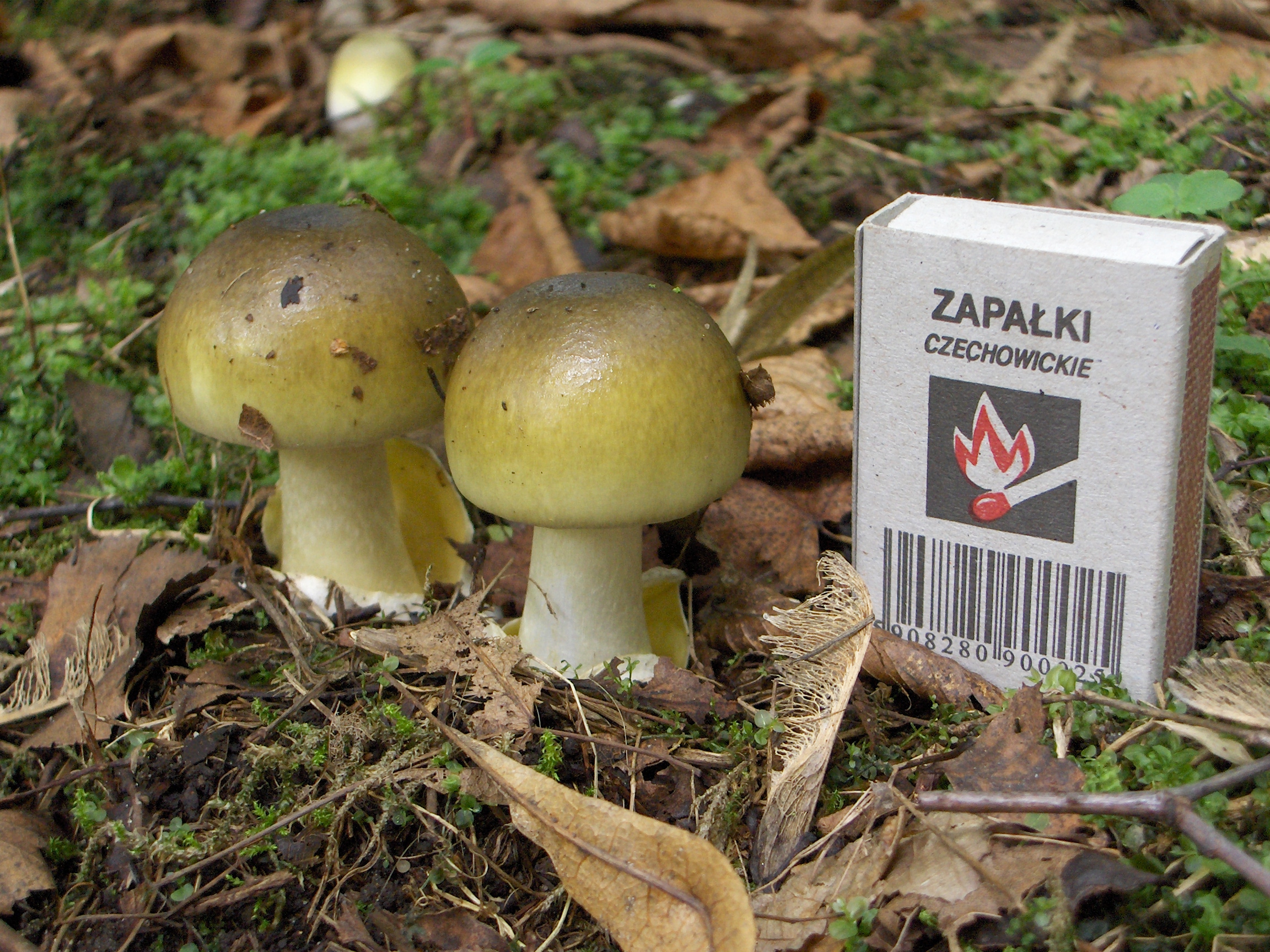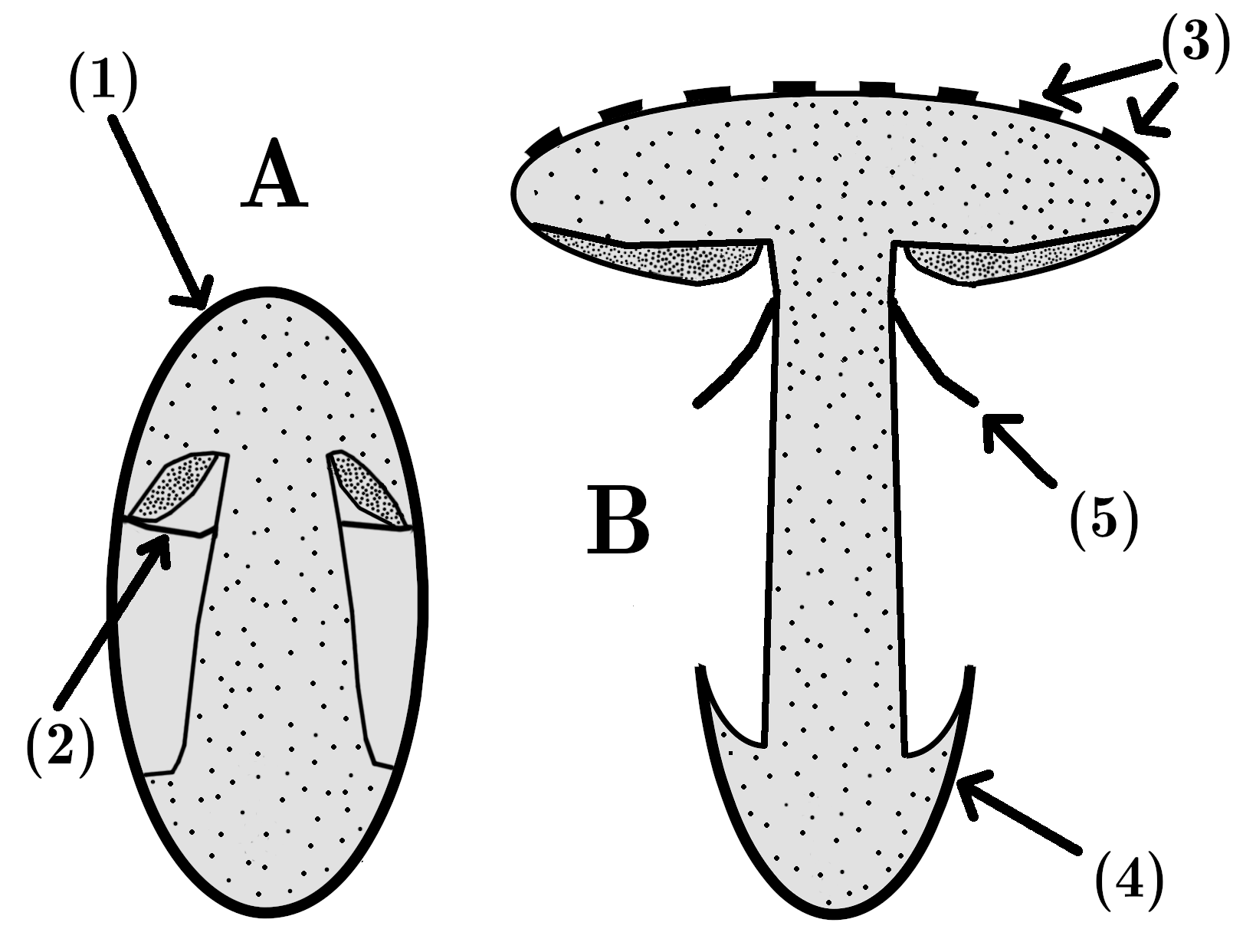|
Universal Veil
In mycology, a universal veil is a temporary membranous tissue that fully envelops immature fruiting bodies of certain gilled mushrooms. The developing Caesar's mushroom (''Amanita caesarea''), for example, which may resemble a small white sphere at this point, is protected by this structure. The veil will eventually rupture and disintegrate by the force of the expanding and maturing mushroom, but will usually leave evidence of its former shape with remnants. These remnants include the volva, or cup-like structure at the base of the stipe, and patches or "warts" on top of the cap. This macrofeature is useful in wild mushroom identification because it is an easily observed, taxonomically significant feature. It is a character present among species of basidiomycete fungi belonging to the genera ''Amanita'' and '' Volvariella''. This has particular importance due to the disproportionately high number of potentially lethal species contained within the former genus. A membrane en ... [...More Info...] [...Related Items...] OR: [Wikipedia] [Google] [Baidu] |
|
 |
Amanita Muscaria 3 Vliegenzwammen Op Rij
The genus ''Amanita'' contains about 600 species of agarics, including some of the most toxic known mushrooms found worldwide, as well as some well-regarded edible species. This genus is responsible for approximately 95% of the fatalities resulting from mushroom poisoning, with the death cap accounting for about 50% on its own. The most potent toxin present in these mushrooms is α-Amanitin. The genus also contains many edible mushrooms, but mycologists discourage mushroom hunters, other than experts, from selecting any of these for human consumption. Nonetheless, in some cultures, the larger local edible species of ''Amanita'' are mainstays of the markets in the local growing season. Samples of this are ''Amanita zambiana'' and other fleshy species in central Africa, '' A. basii'' and similar species in Mexico, '' A. caesarea'' and the "Blusher" ''Amanita rubescens'' in Europe, and '' A. chepangiana'' in South-East Asia. Other species are used for colouring sauces, such as the ... [...More Info...] [...Related Items...] OR: [Wikipedia] [Google] [Baidu] |
 |
Mycology
Mycology is the branch of biology concerned with the study of fungi, including their genetic and biochemical properties, their taxonomy and their use to humans, including as a source for tinder, traditional medicine, food, and entheogens, as well as their dangers, such as toxicity or infection. A biologist specializing in mycology is called a mycologist. Mycology branches into the field of phytopathology, the study of plant diseases, and the two disciplines remain closely related because the vast majority of plant pathogens are fungi. Overview Historically, mycology was a branch of botany because, although fungi are evolutionarily more closely related to animals than to plants, this was not recognized until a few decades ago. Pioneer mycologists included Elias Magnus Fries, Christian Hendrik Persoon, Anton de Bary, Elizabeth Eaton Morse, and Lewis David von Schweinitz. Beatrix Potter, author of '' The Tale of Peter Rabbit'', also made significant contributions to t ... [...More Info...] [...Related Items...] OR: [Wikipedia] [Google] [Baidu] |
|
Gilled Mushroom
An agaric () is a type of fungus fruiting body characterized by the presence of a pileus (cap) that is clearly differentiated from the stipe (stalk), with lamellae (gills) on the underside of the pileus. In the UK, agarics are called "mushrooms" or "toadstools". In North America they are typically called "gilled mushrooms". "Agaric" can also refer to a basidiomycete species characterized by an agaric-type fruiting body. Archaically, agaric meant 'tree-fungus' (after Latin ''agaricum''); however, that changed with the Linnaean interpretation in 1753 when Linnaeus used the generic name ''Agaricus'' for gilled mushrooms. Most species of agaricus belong to the order Agaricales in the subphylum Agaricomycotina. The exceptions, where agarics have evolved independently, feature largely in the orders Russulales, Boletales, Hymenochaetales, and several other groups of basidiomycetes. Old systems of classification placed all agarics in the Agaricales and some (mostly older) sources us ... [...More Info...] [...Related Items...] OR: [Wikipedia] [Google] [Baidu] |
|
|
Amanita Caesarea
''Amanita caesarea'', commonly known as Caesar's mushroom, is a highly regarded edible mushroom in the genus '' Amanita'', native to southern Europe and North Africa. While it was first described by Giovanni Antonio Scopoli in 1772, this mushroom was a known favorite of early rulers of the Roman Empire. It has a distinctive orange cap, yellow gills and stipe. Organic acids have been isolated from this species. Similar orange-capped species occur in North America and India. It was known to and valued by the Ancient Romans, who called it '' Boletus'', a name now applied to a very different type of fungus. Although it is edible, the Caesar's mushroom is closely related to the psychoactive fly agaric, and to the deadly poisonous death cap and destroying angels. Taxonomy and naming ''Amanita caesarea'' was first described by Italian mycologist Giovanni Antonio Scopoli in 1772 as ''Agaricus caesareus'', before later being placed in '' Amanita'' by Persoon in 1801. The com ... [...More Info...] [...Related Items...] OR: [Wikipedia] [Google] [Baidu] |
|
 |
Volva (mycology)
In mycology, a volva is a cup-like structure at the base of a mushroom that is a remnant of the universal veil, or the remains of the peridium that encloses the immature fruit bodies of gasteroid fungi. This macrofeature is important in wild mushroom identification because it is an easily observed, taxonomically significant feature that frequently signifies a member of Amanitaceae. This has particular importance due to the disproportionately high number of deadly poisonous species contained within that family. A mushroom's volva is often partially or completely buried in the ground, and therefore care must be taken to check for its presence when identifying mushrooms. Cutting or pulling mushrooms and attempting to identify them later without having noted this feature could be a fatal error. References {{Reflist, refs= {{cite book , vauthors=Kirk PM, Cannon PF, Minter DW, Stalpers JA , title=Dictionary of the Fungi , edition=10th , publisher=CAB International , location=Wallin ... [...More Info...] [...Related Items...] OR: [Wikipedia] [Google] [Baidu] |
|
Stipe (mycology)
In mycology, a stipe () is the stem or stalk-like feature supporting the cap of a mushroom. Like all tissues of the mushroom other than the hymenium, the stipe is composed of sterile hyphal tissue. In many instances, however, the fertile hymenium extends down the stipe some distance. Fungi that have stipes are said to be stipitate. The evolutionary benefit of a stipe is generally considered to be in mediating spore dispersal. An elevated mushroom will more easily release its spores into wind currents or onto passing animals. Nevertheless, many mushrooms do not have stipes, including cup fungi, puffballs, earthstars, some polypores, jelly fungi, ergots, and smuts. It is often the case that features of the stipe are required to make a positive identification of a mushroom. Such distinguishing characters include: # the texture of the stipe (fibrous, brittle, chalky, leathery, firm, etc.) # whether it has remains of a partial veil (such as an annulus or cortina) or unive ... [...More Info...] [...Related Items...] OR: [Wikipedia] [Google] [Baidu] |
|
 |
Pileus (mycology)
The pileus is the technical name for the cap, or cap-like part, of a basidiocarp or ascocarp ( fungal fruiting body) that supports a spore-bearing surface, the hymenium.Moore-Landecker, E: "Fundamentals of the Fungi", page 560. Prentice Hall, 1972. The hymenium ( hymenophore) may consist of lamellae, tubes, or teeth, on the underside of the pileus. A pileus is characteristic of agarics, boletes, some polypores, tooth fungi, and some ascomycetes. Classification Pilei can be formed in various shapes, and the shapes can change over the course of the developmental cycle of a fungus. The most familiar pileus shape is hemispherical or ''convex.'' Convex pilei often continue to expand as they mature until they become flat. Many well-known species have a convex pileus, including the button mushroom, various '' Amanita'' species and boletes. Some, such as the parasol mushroom, have distinct bosses or umbos and are described as '' umbonate''. An umbo is a knobby protrusion at th ... [...More Info...] [...Related Items...] OR: [Wikipedia] [Google] [Baidu] |
|
Macroscopic
The macroscopic scale is the length scale on which objects or phenomena are large enough to be visible with the naked eye, without magnifying optical instruments. It is the opposite of microscopic. Overview When applied to physical phenomena and bodies, the macroscopic scale describes things as a person can directly perceive them, without the aid of magnifying devices. This is in contrast to observations (microscopy) or theories ( microphysics, statistical physics) of objects of geometric lengths smaller than perhaps some hundreds of micrometers. A macroscopic view of a ball is just that: a ball. A microscopic view could reveal a thick round skin seemingly composed entirely of puckered cracks and fissures (as viewed through a microscope) or, further down in scale, a collection of molecules in a roughly spherical shape (as viewed through an electron microscope). An example of a physical theory that takes a deliberately macroscopic viewpoint is thermodynamics. An example of a ... [...More Info...] [...Related Items...] OR: [Wikipedia] [Google] [Baidu] |
|
 |
Basidiomycota
Basidiomycota () is one of two large divisions that, together with the Ascomycota, constitute the subkingdom Dikarya (often referred to as the "higher fungi") within the kingdom Fungi. Members are known as basidiomycetes. More specifically, Basidiomycota includes these groups: mushrooms, puffballs, stinkhorns, bracket fungi, other polypores, jelly fungi, boletes, chanterelles, earth stars, smuts, bunts, rusts, mirror yeasts, and ''Cryptococcus'', the human pathogenic yeast. Basidiomycota are filamentous fungi composed of hyphae (except for basidiomycota-yeast) and reproduce sexually via the formation of specialized club-shaped end cells called basidia that normally bear external meiospores (usually four). These specialized spores are called basidiospores. However, some Basidiomycota are obligate asexual reproducers. Basidiomycota that reproduce asexually (discussed below) can typically be recognized as members of this division by gross similarity to others, by the form ... [...More Info...] [...Related Items...] OR: [Wikipedia] [Google] [Baidu] |
 |
Amanita
The genus ''Amanita'' contains about 600 species of agarics, including some of the most toxic known mushrooms found worldwide, as well as some well-regarded edible species. This genus is responsible for approximately 95% of the fatalities resulting from mushroom poisoning, with the death cap accounting for about 50% on its own. The most potent toxin present in these mushrooms is α-Amanitin. The genus also contains many edible mushrooms, but mycologists discourage mushroom hunters, other than experts, from selecting any of these for human consumption. Nonetheless, in some cultures, the larger local edible species of ''Amanita'' are mainstays of the markets in the local growing season. Samples of this are ''Amanita zambiana'' and other fleshy species in central Africa, '' A. basii'' and similar species in Mexico, '' A. caesarea'' and the "Blusher" ''Amanita rubescens'' in Europe, and '' A. chepangiana'' in South-East Asia. Other species are used for colouring sauces, such as the ... [...More Info...] [...Related Items...] OR: [Wikipedia] [Google] [Baidu] |
.jpg) |
Volvariella
''Volvariella'' is a genus of mushrooms with deep salmon pink gills and spore prints. Description They lack a ring, and have an Amanita-like volva at the stem base. Some species of Amanita look similar, but Amanita has white spores and often have a ring. Since the gills of young ''Volvariella'' are white at first, they are more easily mistaken for ''Amanita''. The genus is estimated to contain about 50 species. Species Many sources list ''Volvariella'' as a member of the Pluteaceae family, but recent DNA studies have revealed that '' Pluteus'' and ''Volvariella'' evolved separately and have very different DNA. These studies show that ''Volvariella'' is very closely related to "schizophylloid" mushrooms like ''Schizophyllum commune''. Some species of ''Volvariella'' are popular edibles in Europe, accounting for 16% of total production of cultivated mushrooms in the world. Cultivation and edibility '' Volvariella volvacea'', well known as the "paddy straw mushroom", is c ... [...More Info...] [...Related Items...] OR: [Wikipedia] [Google] [Baidu] |